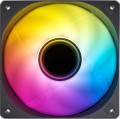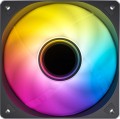-
Fan. A classic fan is a motor with blades that provides air flow; This also includes sets of several fans. In any case, such devices should not be confused with coolers (see below) - fans do not have radiators. Almost all solutions of this type are designed for cases (see “Purpose”), only a few models are designed for “airflow” hard drives or chipsets.
—
Reversible fan. A type of fan (see above) in which the impeller is turned in the opposite direction. This was done so that when placed behind the “system unit” case or in its upper part, it was possible to give the assembly an aesthetic appearance - the reversible fan will be installed with the front side for air airflow. Such solutions are used mainly for the side walls of “aquarium” type housings.
—
Radiator. Design made of heat-conducting material with a special ribbed shape. This shape provides a large area of contact with air, and as a result, good heat transfer. Radiators do not consume energy and operate absolutely silently, but are not very efficient. Therefore, in their pure form they are extremely rare, and such models are intended either for low-power PC components with low heat dissipation (energy-efficient processors, hard drives, etc.), or for assembling an active cooler (see below) from a separately purchased fan and radiator (this option is found among solutions for video cards).
<
...br>
— Active cooler. A device in the form of a radiator with a fan installed on it; Moreover, in many models, the radiator does not directly contact the cooled component, but is connected to it using heat pipes, while air is blown out to the side (the so-called tower layout, especially popular in systems for CPU; for more details, see “Blowing air flow”) . In any case, such designs, on the one hand, are relatively simple and inexpensive, on the other hand, they are quite effective, making them an extremely popular type of CO. In particular, it is in this format that most solutions for processors are produced (including tower and boxed ones), and in general, coolers can be used for almost any component of the system, with the exception of the case.
- Water cooling. Water cooling systems consist of three main parts: a water block in direct contact with the component to be cooled (usually the processor), an external cooler, and a pump (either separate or built into the cooler). These components are connected by hoses through which water (or another similar coolant) circulates - it provides heat transfer. And the cooling unit is usually a cooler - a system of fans and radiators that dissipates thermal energy into the surrounding air. Water systems are noticeably more efficient than active coolers (see above); they are suitable even for very powerful and “hot” CPUs, which traditional coolers have difficulty coping with. On the other hand, this type of cooling is quite cumbersome and difficult to install, and is not cheap.
— LSS kit. Kit for self-assembly of a liquid (water) cooling system. In this case, it is understood that the entire system is supplied in the form of a set of parts, from which the customer must assemble the finished life-support system himself. Its installation is more complex than traditional water systems. Therefore, there are only a few LSS kits produced, and they are designed mainly for enthusiasts who like to experiment with the design and design of their PCs.
- Backplate. A solid metal plate used as a fastening element for the cooling system. Serves to prevent bending of the motherboard or video card when deploying a heat dissipation system, and also provides passive cooling of the rear side of tech modules with which it is adjacent.
— Water block VRM. A water block that provides effective cooling of the elements of the VRM (Voltage Regulator Module) power subsystem of the central processor.
— CPU water block. A copper or nickel heat exchanger designed to remove heat from the CPU through the coolant. Used in water cooling systems for computers. Most often, processor water blocks are equipped with mounts for specific processor platforms.
- GPU water block. Liquid cooling units for maximum efficient heat removal from the video card. Similar solutions are produced for a specific group of video cards on one graphics processor. GPU water blocks consist of two main parts: the top, where a copper alloy heat sink is located, a plastic cover with liquid channels and a casing to give rigidity to the structure, as well as a metal plate at the bottom of the block on the back side of the printed circuit board.
— A set of fastenings. A set of fasteners for mounting cooling systems on elements of a computer motherboard. Available for specific socket versions.
